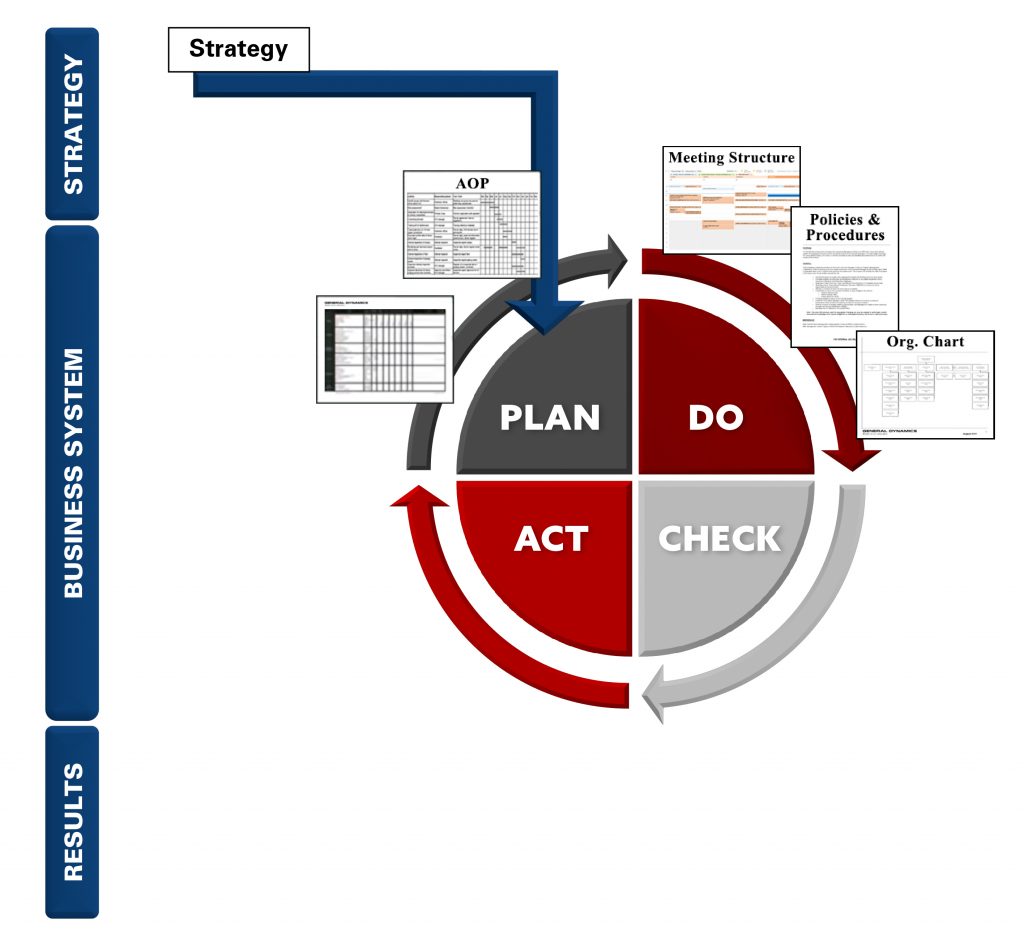[Post by Chuck Krugh, December 2, 2022]
I hope everyone had a great Thanksgiving last week and enjoyed some time with family and friends.
In my last blog, I talked about the first quadrant of our Business Operating System (BOS), “PLAN,” and the inputs into it: strategy.
I also described two ways to look at strategy – the high-level five-year plan and the more detailed Annual Operating Plan (AOP), which is supported by our action plans.
As we go through the Plan-Do-Check-Act cycle, once we have our plan, we then move onto the next BOS quadrant – “DO.”
The second quadrant, “DO,” is the execution stage of the BOS. When I say execution stage, I mean the stage when we design, plan, purchase and build products in our facilities.
Of course, at the company’s most basic level, we build ships. What we are focusing on in our BOS is how we manage that production as a company. A business operating system is a system that can manage any company, so the elements we’re laying out in our BOS model here highlight how the company operates overall rather than production-specific tasks.
Therefore, in the “DO” quadrant, we show three of our company’s controlling documents: organizational charts, meeting structure, and policies and procedures. These three controls form the high-level, core elements of the “DO” quadrant because they define who is responsible for doing the work (organizational chart), how the work gets done (policies and procedures) and how we communicate with our colleagues about the work (meeting structure).
Of these three controlling documents, the organizational chart is probably the most basic and well known. It lays out in a visual format who reports to whom. This is the company’s command and control structure.
Many people look at an org chart and assign importance to where a person is in the chart’s hierarchy. I believe that is not the right way to view the roles shown on the chart. As I told you all in my town hall meetings last June, the decisions you make at the point of execution are usually more important and have a greater impact than the decisions I make daily. Your choices each day to do the work on time, to eliminate rework or to solve a problem have a huge impact on our company. Therefore, to me, the org chart shows the levels of responsibility and who is responsible for what, not levels of importance.
The second set of documents in “DO” is the policies and procedures. Every company puts policies and procedures in place. These guidelines tell us how we should do work, describe what acceptable behaviors are and specify the times we come to work as well as set pay grades, performance standards and so forth. These rules guide us in our daily work.
Our policies and procedures include corporate policies, our collective bargaining agreements, safety procedures and many others. Because they not only establish our company operations but also affect how we work each day, it’s important they have a place in our BOS.
The third guiding document for how we do our work is the meeting structure. Meetings are a tool we use to enhance communication, develop possible solutions to problems, solve problems and organize both our teams and our work.
Having the right number of meetings is crucial to the business’s success. Too many meetings or too few are equally problematic. One way to develop the “right” number and timing of meetings is to create a standard meeting calendar. The standard meeting calendar organizes the high-value meetings needed to run the business and eliminates meetings that are redundant or don’t add value.
The Muster 1–4 meetings implemented in August fall into the high-value meeting category. This meeting series has been designed to resolve problems and clear the path for mechanics so they can do their daily work. The musters allow problems to be raised at the start of the shift and then rise to the level of responsibility where they can be solved.
Our goal is to solve problems at the lowest level possible, closest to the point of execution, but some problems need more help than a single crew or supervisor can provide. Those problems are raised to the successive musters (2, 3 or 4) for resolution.
By Muster 4 at 0930 every morning, the entire company should have identified the hottest problems and be working to solve them at the right level. Muster 4 includes not just Operations leadership, but Facilities, Supply Chain, Safety, Engineering and others who are assigned problems for resolution and who are also required to report back. The Senior Leadership Team and I attend the Muster 4 meeting each day. It’s that important.
The Muster 1–4 meetings are an example of cascading meetings. We’ll talk more about cascading meetings in a later blog.
I realize this can be a lot to take in. Know that as we apply the Business Operating System to our daily activities and the important work we do, it will become more familiar.
As always, stop me if you have any questions when I see you on the deckplates!
Safely Execute High-Quality Work
Chuck
President, General Dynamics Bath Iron Works
Click here to view more From the Helm blog posts.

